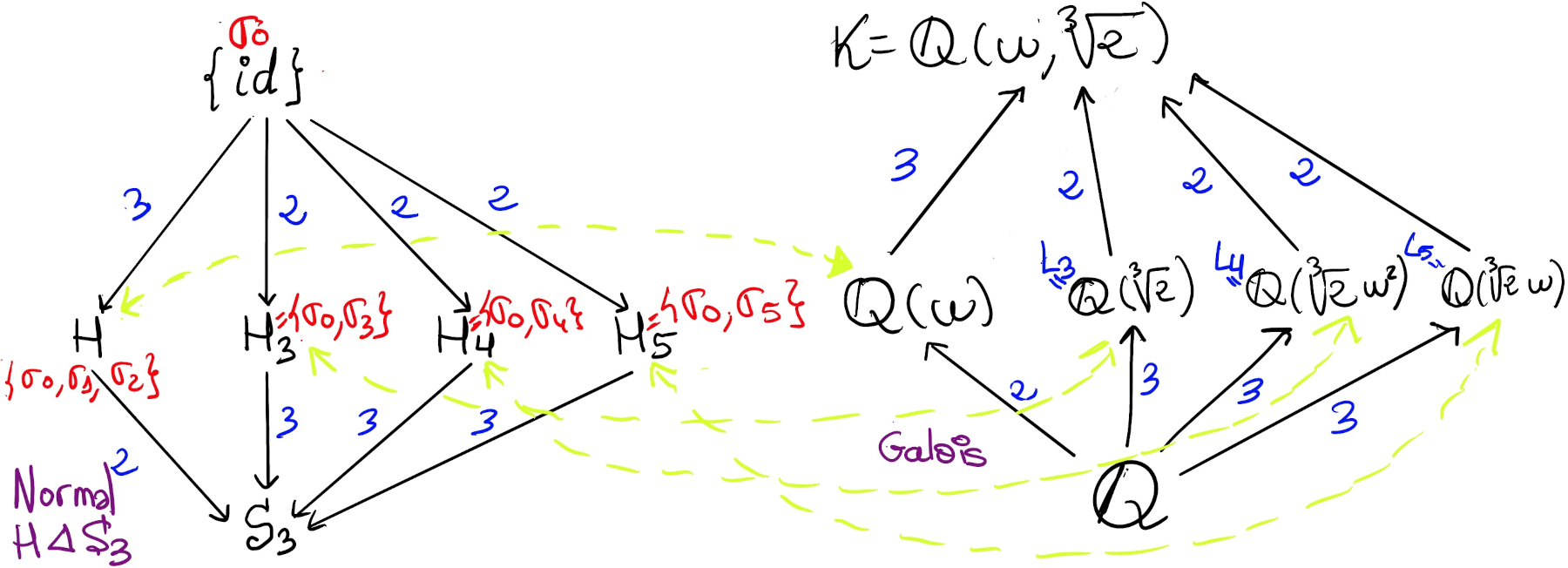
|
 |
 |

|
 |
 |
There is nothing more practical than a good theory, Leonid Brezhnev.

Theorem. Let K/F be a finite extension. The following statements are equivalent:
Fundamental Theorem of Galois Theorem. Let K/F be a finite separable extension, i.e., a Galois extension. Let G = Gal(K/F) be the Galois group. Then, the following statements holds, (1) There is an inclusion-reversing bijective map or correspondence from subgroups of G and intermediate fields of K/F, given by H → KH, its inverse is defined by L → Gal(K/L). H1 ⊇ H2 ⇒ KH1 ⊆ KH2 and L1 ⊆ L2 ⇒ Gal(K/L1) ⊇ Gal(K/L2). Futhermore, it satisfies the following equality |H| = [K : KH] and [G : H] = [KH : F]
(2) Suppose an intermediate field L (F ⊆ L ⊆ K) corresponds to the subgroup H under the Galois correspondence. K/L is always normal (hence Galois). L is Galois over F if and only if H = Gal(K/L) is a normal subgroup of G, H = Gal(K/L) ◁ G In this case, the Galois group of L/F is isomorphic to the quotient group G/H, i.e., Gal(L/F) ≋ G/Gal(K/L)
[K: ℚ] = 4, and K as a vector space over ℚ has a basis {$1, \sqrt{3}, \sqrt{5}, \sqrt{15}$} and dimℚK = 4, so every element a ∈ K can be written uniquely as $a + b\sqrt{3} + c\sqrt{5} + d\sqrt{15}$. σ is defined uniquely as $a + b\sqrt{3} + c\sqrt{5} + d\sqrt{15} → a - b\sqrt{3} + c\sqrt{5} - d\sqrt{15}$, τ: $a + b\sqrt{3} + c\sqrt{5} + d\sqrt{15} → a + b\sqrt{3} - c\sqrt{5} - d\sqrt{15}$, μ: $a + b\sqrt{3} + c\sqrt{5} + d\sqrt{15} → a - b\sqrt{3} - c\sqrt{5} + d\sqrt{15}$
Why [K : ℚ] = 4? We build the tower, $\mathbb{Q} ⊆ \mathbb{Q}(\sqrt{3}) ⊆ \mathbb{Q}(\sqrt{3}, \sqrt{5})$. A) $\sqrt{3}∉\mathbb{Q}$, x2 -3 is irreducible in ℚ, and degree(x2-3) = 2 ⇒ [$\mathbb{Q}(\sqrt{3}) : \mathbb{Q}$] = 2. B) $\sqrt{5}∉\mathbb{Q}(\sqrt{3})$, x2 -5 is irreducible in $\mathbb{Q}(\sqrt{3})$, and degree(x2-5) = 2 ⇒ [$\mathbb{Q}(\sqrt{3}, \sqrt{5}):\mathbb{Q}(\sqrt{3})$] = 2 ⇒ C) [K : ℚ] = [$\mathbb{Q}(\sqrt{3}, \sqrt{5}):\mathbb{Q}(\sqrt{3})$][$\mathbb{Q}(\sqrt{3}) : \mathbb{Q}$] = 2·2 = 4
K/ℚ is normal. Then K/ℚ is a finite normal extension if and only if it is the splitting field of some polynomial f(x) ∈ K[x]. It suffices to consider f(x) = (x2 -3)(x2 -5). Its splitting field must contain $\sqrt{3}$ and $\sqrt{5}$ and since K is the smallest field containing both of them, K must be in fact the splitting field of f(x) ⇒ K is normal over ℚ.
Futhermore, K has 3 subfields L such that [K : L] = 2 (⇒ [L : ℚ] = 2), namely $ℚ(\sqrt{2}),ℚ(\sqrt{3}),ℚ(\sqrt{6})$, and $\mathbb{Q}(\sqrt{2},\sqrt{3})=\mathbb{Q}(\sqrt{2} +\sqrt{3})$
K/ℚ is normal. Then K/ℚ is a finite normal extension if and only if it is the splitting field of some polynomial f(x) ∈ K[x]. It suffices to consider f(x) = (x2 -2)(x2 -3). Its splitting field must contain $\sqrt{2}$ and $\sqrt{3}$ and since K is the smallest field containing both of them, K must be in fact the splitting field of f(x) ⇒ K is normal over ℚ.
Reclaim: Any degree 2 extension is normal, but it does not necessarily have to be Galois.
[$\mathbb{Q}(\sqrt[3]{2}, w): \mathbb{Q}$] = 2 · 3 = 6. We know K is the splitting field of x3 - 2 over ℚ (the roots are $\sqrt[3]{2}, \sqrt[3]{2}w, \sqrt[3]{2}w^2$, they are all in K and if you remove any of them, you don’t get K, it is generated by all its roots) ⇒ K/ℚ is normal.
The possible images of $\sqrt[3]{2}$ are $\sqrt[3]{2}, \sqrt[3]{2}w, \sqrt[3]{2}w^2$, and w can be mapped to w and w2. There exists a homomorphism K → K for every choice of images $\sqrt[3]{2}$ and w, so there are 6 (3 x 2 choices) automorphism K → K, |Gal(K/ℚ)| = 6 = [K : ℚ] ⇒ K/ℚ is Galois
$\sqrt[3]{2}$ and w are linear independent, and their images are to be chosen independently (the conjugates of a root, say α, are the images of α under the field homomorphism) of each other because $\sqrt[3]{2}$ ∈ ℝ, and w is not real. Futhermore, there exists a homomorphism K → K for every choice of images of w and $\sqrt[3]{2}$, it will send any root to one of its conjugates.
Finally, what is Gal(K/ℚ)? There are only two groups of order 6 up to isomorphism, namely the cyclic group ℤ/6ℤ (Abelian), and the symmetric group of order 3, S3.
σ4∘σ5 = σ2 ≠ σ1 = σ5∘σ4 ⇒ Gal(K/ℚ) is not Abelian ⇒ Gal(K/ℚ) ≋ S3
Let’s have a look at the subgroups. The trivial subgroups are S3 (whose extension is ℚ) and {σ0 = id} (whose extension is K). The order of the proper subgroups can only be a divisor of 6 by Lagrange’s Theorem, so we are left with 2 or 3.
It is left to the reader to check that σ32 = σ42 = σ52 = σ0
Therefore, we have the following subgroups of order 2, namely H3 = {σ0, σ3}, H4 = {σ0, σ4}, and H5 = {σ0, σ5}. None of them are normal (H◁G iff ∀g ∈ G, gNg-1 ⊆ N), e.g., H4 is not normal because σ5∘σ4∘σ5-1 = [σ52 = σ0 = id] σ5∘σ4∘σ5 = σ1∘σ5 = σ5 ∉ H4. Therefore, the corresponding field extensions (Li is the extension whose Galois group is Hi) are not Galois.
Notice that $σ_3(\sqrt[3]{2}) = \sqrt[3]{2} ⇒ ℚ(\sqrt[3]{2}) ⊆ L_3$
Therefore, $ℚ(\sqrt[3]{2}) ⊆ L_3$ and [L3 : $ℚ(\sqrt[3]{2})$] = 1 ⇒ L3 = $ℚ(\sqrt[3]{2})$. Following a similar argument, we can demonstrate that L4 = $ℚ(\sqrt[3]{2}w^2)$ (Notice: $σ_4(\sqrt[3]{2}w^2) = \sqrt[3]{2}ww^4 = \sqrt[3]{2}w^2$), and L5 = $ℚ(\sqrt[3]{2}w)$ ($σ_5\sqrt[3]{2}w = \sqrt[3]{2}w^2w^2 = \sqrt[3]{2}w$). In fact, these three extensions are isomorphic because they adjoin roots to ℚ of the same irreducible polynomial (x3 -2), that is, ℚ(α1) ≋ ℚ(α2) ≋ ℚ(α3) ≋ ℚ[x]/⟨x3 -2⟩.
As for subgroups of order 3 (they are isomorphic to ℤ3), we just need to find non trivial elements of order 3. It is left to the reader to show that σ1 and σ2 are elements of order 3, σ1∘σ2 = σ2∘σ1 = σ0, so we have only one subgroup of order 3, namely, L = {σ0, σ1, σ2}. σi(w) = w, 0 ≤ i ≤ 2 ⇒ ℚ(w) ⊆ L
Therefore, L = ℚ(w). Futhermore, since H ◁ G (all subgroups of index 2 are normal) ⇒ ℚ(w)/ℚ is a Galois extension (the splitting field of a separable polynomial x2 +x +1). The following are two diagrams with the subgroups of S3 ≋ Gal(K/ℚ) and their corresponding fixed fields.

Gal(K, ℚ) = ⟨σ2, σ3, σ5⟩ ≋ ℤ/2ℤ x ℤ/2ℤ x ℤ/2ℤ. You can think (a, b, c) ∈ ℤ/2ℤ x ℤ/2ℤ x ℤ/2ℤ as representing $\sqrt{2}→(-1)^a,\sqrt{3}→(-1)^b, \sqrt{5}→(-1)^c$.
K/ℚ is a Galois extension (normal and separable) since K is the splitting field of the polynomial (x2 -2)(x2 -3)(x2 -5) and ℚ is the base field (char(ℚ) = 0). Another way of seeing this is [K : ℚ] = 8 = |Gal(K/ℚ)|.
Fact: The square roots of different primes are linearly independent over the field of rationals
What is KGal(K/ℚ). We know [K : KGal(K/ℚ)] = |Gal(K/ℚ)| = 2
Since [K : ℚ] = 4 ⇒ [KGal(F/ℚ) : ℚ] = 2.
Notice that $σ(\sqrt{2}) = σ(\sqrt[4]{2}\sqrt[4]{2})= σ(\sqrt[4]{2})^2 = (-\sqrt[4]{2})^2 = \sqrt{2} ⇒\sqrt{2}$ is fixed by 1 and σ ⇒ $\mathbb{Q}(\sqrt{2})⊆\mathbb{K}^{Gal(\mathbb{K}/\mathbb{Q})}$
$\mathbb{Q}(\sqrt{2})⊆\mathbb{K}^{Gal(\mathbb{K}/\mathbb{Q})}$ ⇒ $\mathbb{Q}(\sqrt{2})=\mathbb{K}^{Gal(\mathbb{K}/\mathbb{Q})}$
F finite, p = char(F) > 0. [Classification of finite fields. Let F be a finite field of order q = pr. Then, K is the splitting field of the polynomial xq-x ∈ $\mathbb{F}_p[x]$.] K is the splitting field of $x^{p^{r}}-x~ over~ \mathbb{F_p}$ ⇒ the extension is normal.
Let σ: K → K, σ(α) = αp, σ is a field homomorphism (x + y)p = xp + yp because when p is prime ⇒ p | ${p \choose k}$, injective ⇒ If a set X is finite, an injective map f: X → X is also surjective. Futhermore, σ(a) = a ∀a ∈ Fp ⇒ σ is an F-automorphism of K, i.e., σ ∈ Gal(K/F).
σ is injective because F field, Φ: F→ F, Ker(Φ) is an ideal of F, a field ⇒ KerΦ={e} or KerΦ = F ⇒ Φ is 1-1 because ker(Φ) is the trivial ideal, or Φ is zero (⊥ because ker(Φ) = F).
Notice σ2(α) = σ(σ(α)) = σ(αp) = (αp)p = $α^{p^{2}}, σ^i(α)=α^{p^{i}}$ ∀α ∀i ≥ 1
Let’s suppose order of σ is n, σn = id, i.e, σn(α) = α ∀α ∈ K ⇒ $σ^n(α)=α^{p^{n}}=α$ ⇒ ∀α ∈ K, α is a root of f(x) = $x^{p^{n}}-x$ in K. Since deg(f(x)) = pn, f(x) has at most pn roots. However, every element of K is a root of f ⇒ |K| = pr ≤ pn ⇒ r ≤ n.
Theorem. A polynomial f of degree n over a field F has at most n roots in F.
Futhermore, [Classification of finite fields. Let F be a finite field of order q = pr. Then, F is the splitting field of the polynomial xq-x ∈ $\mathbb{F}_p[x]$. K is the splitting field of $x^{p^{r}}-x~ over~ \mathbb{F_p}$] $σ^r(α)=α^{p^{r}}=α$ ⇒ σr = 1 ⇒ order(σ) ≤ r ⇒ n = r ⇒ The subgroup generated by σ in $Gal(\mathbb{F_{p^r}}/\mathbb{F_p})$ = {1, σ, σ2,···, σr-1} has order r ⇒ $|Gal(\mathbb{F_{p^r}}/ \mathbb{F_p})|$ ≥ r.
$r = [\mathbb{F_{p^r}} : \mathbb{F_p}] ≥ [F_{p^r} : F_{p^r}^G] = |Gal(\mathbb{F_{p^r}}/ \mathbb{F_p})|≥ r ⇒ [\mathbb{F_{p^r}} : \mathbb{F_{p^r}^G}] = r~ and~ [F_{p^r}^G : \mathbb{F_p}] = 1 ⇒ \mathbb{F_{p^r}^G} = \mathbb{F_p} ⇒ \mathbb{F_{p^r}}/ \mathbb{F_p}$ is Galois.
Futhermore, $Gal(\mathbb{F}_{p^r}/ \mathbb{F}_p)≋ℤ/rℤ$ because we have already found an automorphism of order r, so it is cyclic.